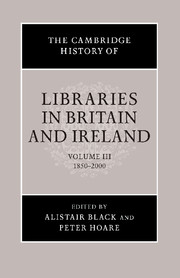Book contents
- Frontmatter
- Introduction: sources and methodologies for the history of libraries in the modern era
- 1 Libraries and the modern world
- Part One Enlightening the Masses: the Public Library as Concept and Reality
- Part Two The Voluntary Ethic: Libraries of our Own
- Part Three Libraries for National Needs: Library Provision in the Public Sphere in the Countries of the British Isles
- Part Four The Nation's Treasury: Britain's National Library as Concept and Reality
- Part Five The Spirit of Enquiry: Higher Education and Libraries
- Part Six The Rise of Professional Society: Libraries for Specialist Areas
- 31 Libraries and information for specialist areas
- 32 The scientist and engineer and their need for information
- 33 Information in the service of medicine
- 34 Lawyers and their libraries
- 35 Spreading the Word: religious libraries in the ages of enthusiasm and secularism
- 36 Government and parliamentary libraries
- 37 Company libraries
- 38 Rare-book libraries and the growth of humanities scholarship
- Part Seven The Trade and its Tools: Librarians and Libraries in Action
- Part Eight Automation Pasts, Electronic Futures: the Digital Revolution
- Bibliography
- Index
- References
38 - Rare-book libraries and the growth of humanities scholarship
from Part Six - The Rise of Professional Society: Libraries for Specialist Areas
Published online by Cambridge University Press: 28 March 2008
- Frontmatter
- Introduction: sources and methodologies for the history of libraries in the modern era
- 1 Libraries and the modern world
- Part One Enlightening the Masses: the Public Library as Concept and Reality
- Part Two The Voluntary Ethic: Libraries of our Own
- Part Three Libraries for National Needs: Library Provision in the Public Sphere in the Countries of the British Isles
- Part Four The Nation's Treasury: Britain's National Library as Concept and Reality
- Part Five The Spirit of Enquiry: Higher Education and Libraries
- Part Six The Rise of Professional Society: Libraries for Specialist Areas
- 31 Libraries and information for specialist areas
- 32 The scientist and engineer and their need for information
- 33 Information in the service of medicine
- 34 Lawyers and their libraries
- 35 Spreading the Word: religious libraries in the ages of enthusiasm and secularism
- 36 Government and parliamentary libraries
- 37 Company libraries
- 38 Rare-book libraries and the growth of humanities scholarship
- Part Seven The Trade and its Tools: Librarians and Libraries in Action
- Part Eight Automation Pasts, Electronic Futures: the Digital Revolution
- Bibliography
- Index
- References
Summary
The idea of rarity
What makes a book ‘rare’ has been a subject of discussion since the eighteenth century when systematic enquiry into the question began, when naturally the discussion was conducted in the universal language of scholarship – Latin, which was also the language of rare books. But vernacular works also became sought-after and rare, and William Oldys’s The British Librarian (1738) was the first systematic published guide to rare books in English, followed by James Savage's periodical The librarian, being an account of scarce, valuable and useful English books, manuscripts, libraries, public records, etc., 3 vols. (1808–9). By the beginning of the nineteenth century it was becoming clearer that the market value of books deemed rare had become a significant factor in this judgment. The concept of rarity necessarily implies more than one copy of a printed book, and is associated not only with book collecting, dealt with in more detail elsewhere, but also with the commercial trade in books. The defining event for Britain was the founding of the aristocratic Roxburghe Club (1812) which inspired book collectors throughout the country to collect, catalogue and display their rare books, and naturally to emphasise the rarity of books in the vernacular, as opposed to those in the previously universal scholarly language. The work of Thomas Frognall Dibdin (1776–1847), Earl Spencer's librarian, provided theoretical and practical guidance for the book collectors of his day. Book collecting inevitably carried over to the public libraries established later in the century, whose collections began to emulate those of distinguished private collectors.
- Type
- Chapter
- Information
- The Cambridge History of Libraries in Britain and Ireland , pp. 503 - 520Publisher: Cambridge University PressPrint publication year: 2006



